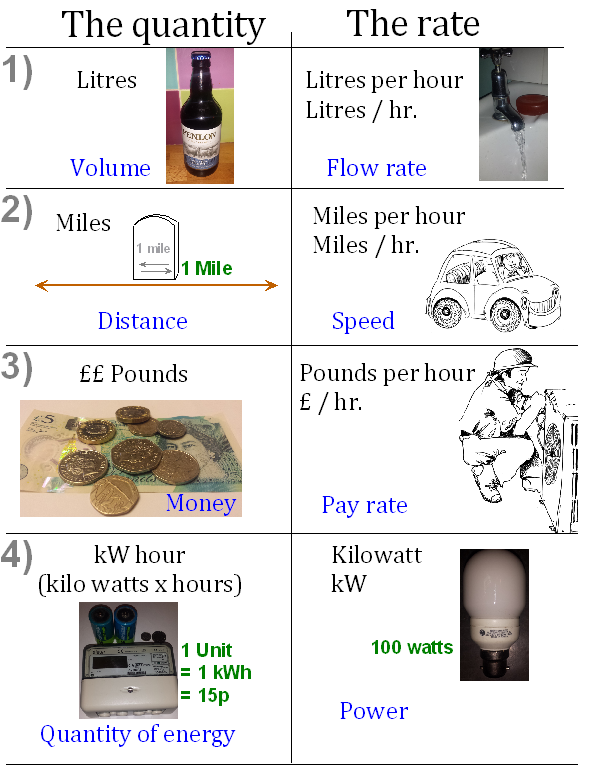There is a little detail that annoys many people. It’s the confusion that seems to arise over the commonly used units of energy and power
I came across this the other day and pondered why it’s a common error. When we drill into the details, we can see why confusion could arise.
We are all used to lots of things that are – ‘per hour’ e.g. Speed in miles per hour, water flow-rate in Litres per hour, wages in Pounds (££) per hour.
The unit of energy – kwh, is the odd one out. There is no ‘per’ involved. We will come back to that in a minute.
If you think about it historically; miles, litres and money came well before any thought of needing the ‘per hour’ rate of these things. E.g. We measured Miles well before we thought of needing a unit for speed…. Miles per hour.
Apart from in science circles (who got it right of course), I would think that the units of power and energy evolved historically the other way around. The first unit required was power – the horsepower, the watt, or the kilowatt. When we first started generating electrical power, it was horse-power or Kwatts that was the all-important unit. E.g Watts as a measure of the intensity of a light bulb etc.
The next consideration would have been measuring the total quantity of power over time. If we generate 1kW of power, then after 1 hr, we have a quantity of energy of 1 kW multiplied by 1 hour. In a whole day, we would have 24 kWhrs (kW x Hrs), or 24 units of electricity. Now a utility bill can be sent!!
The image below illustrates various examples of quantities of something on the left, with the corresponding rate to the right.

The first 3 above are easy to understand, but the last one is a little strange. Given the common unit for power was the kWatt (on the right), then to find a unit of quantity we need to multiply power by time, not divide by time as for other units.
One important point to mention, that some people miss, is the ‘/’. This means ‘divided by’ or ‘per’. However if we want a ‘multiply by’ in our units, what do we put?? We put NOTHING! How confusing is that!
e.g. Miles per hour or miles divided by hours = miles / hr.
Kilowatts multiplied by time = kW hr.
That gap in between the kW and h means ‘multiply-by’ ! I know its so obvious to scientists, but if we actually put something in the gap it might make it more understandable. E.g. if we said ‘kW hrs’, but wrote kW.hrs,
Maybe it’s no wonder that there is confusion.
So here is how to never get it wrong again.
kWatt is the amount of Power.
A 40kW car engine, a 2kW kettle, a 50W light bulb
kWatt hr. is a quantity of energy.
One kWh is one unit of electricity and costs about 15 pence. A typical household may use 5,000 kWh of electricity over a year. (costing £750)
kWatt/hr. is unheard-of
At the risk of causing more confusion, the use of kWh whilst understandable is not necessarily the best choice of units for measuring energy as it both divides by units of time (seconds) and multiplies by units of time (hours).
I think the real problem comes form the use of kWh whereas scientists have a unit Joules (J) for energy. One Joule/second (J/s) is one Watt and 1000 Joules per second is 1kW and 1000 Joules per second for 1 hour is 3600000 Joules or 3600 kJor 3.6 MJ which is 1kWh.
kW/hr (or kW/s) occurs when, for example, a generator is starting up and its power is increasing, just like miles per hour per hour when a car is accelerating. In both cases though, I suspect is is only scientists and engineers who would make use of such figures.
However, and just to complicate matters, KWHr/hr is perfectly valid as long as one remembers the concept of equivalency. A KWHr is equivalent to an amount of money or some medium of exchange and so KWHr/hr is a value for the cost of running an energy consuming device. If the Hr units are cancelled (as one might be tempted to do) then the unit label reverts to KW which is meaningless in the cost context. Dimensional analysis is a wonderful tool!
And thanks for an excellent exposition on various subjects.
Regards Dave